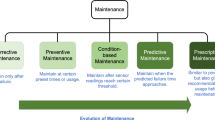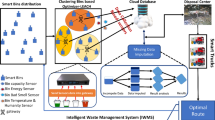Abstract
In existing overflow remote intelligent monitoring system, a huge amount of data uploading and multiple processing brings great challenges to the bandwidth load and real-time feedback of the server. Based on the Multiple Access Edge Computing Architecture (MEC), this paper proposes an Internet of Things overflow intelligent monitoring system based on multi-access edge computing. As the middle layer of the system, edge computing can provide real-time local services for field devices, and it can reduce the data uploading amount by preliminarily analyzing the computing tasks of the cloud computing platform. At the same time, for the current domestic and international artificial intelligence-based overflow warning model, it needs a large amount of prior knowledge or training data before use, and the accuracy, real time, and reliability of overflow monitoring are limited by prior knowledge and training data and other issues. In this paper, the information entropy theory has been adopted to improve fuzzy c-means clustering (FCM) algorithm to overcome the disadvantage that the user gives the number of clustering actively in FCM clustering. Then, considering the correlation between the occurrence of overflow accident and the changing trend of standpipe pressure and casing pressure, an intelligent early warning model of drilling overflow accident is proposed by using the improved FCM clustering method based on information entropy. The early warning model uses the adaptive determination of the number of clusters for clustering, which not only ensures the quality of the cluster but also improves the accuracy and reliability of the overflow warning. The warning result of the overflow accident is output according to the clustering fitting result and the sensitivity of the overflow accident. Finally, the drilling data of YY oil well in XX oilfield considered as the research object.















Similar content being viewed by others
References
Chen P (2005) Drilling and well completion engineering. Petroleum Industry Press, Beijing
Liang H, Sun Y, Li G et al (2019) Gray relational clustering model for intelligent guided monitoring horizontal wells. Neural Comput Appl 31:1339–1351. https://doi.org/10.1007/s00521-018-3645-4
Bader A, Ghazzai H et al (2016) Front-end intelligence for large-scale application-oriented internet-of-things. IEEE Access 4:3257–3272. https://doi.org/10.1109/ACCESS.2016.2580623
Pawani P, Jude O, Madhusanka L et al (2018) Survey on multi-access edge computing for internet of things realization. IEEE Commun Surv Tutor 20(99):2961–2991. https://doi.org/10.1109/COMST.2018.2849509
Premsankar G, DiFrancesco M et al (2018) Edge computing for the internet of things: a case study. IEEE Internet Things J 5:1275–1284. https://doi.org/10.1109/JIOT.2018.2805263
Liang H, Zou J, Khan MJ et al (2019) An sand plug of fracturing intelligent early warning model embedded in remote monitoring system. IEEE Access 7:47944–47954. https://doi.org/10.1109/ACCESS.2019.2909647
Deng HX, Wei GH, Li JL et al. (2018) An overflow intelligent early-warning model based on downhole parameters measurement. In: International conference on image and video processing, and artificial intelligence. International Society for Optics and Photonics 10836: 1083624. https://doi.org/10.1117/12.2514042
Liang H, Zou J, Liang W (2017) An early intelligent diagnosis model for drilling overflow based on GA–BP algorithm. Cluster Comput 2:1–20. https://doi.org/10.1007/s10586-017-1152-5
Abonyi J, Szeifert F (2003) Supervised fuzzy clustering for the identification of fuzzy classifiers. Pattern Recognit Lett 24(14):2195–2207. https://doi.org/10.1016/s0167-8655(03)00047-3
Zhao Z et al (2018) Deploying edge computing nodes for large-scale IoT: a diversity aware approach. IEEE Internet Things J 5:3606–3614. https://doi.org/10.1109/JIOT.2018.2823498
Cheng B, Papageorgiou A, Cirillo F, et al. (2015) GeeLytics: geo-distributed edge analytics for large scale IoT systems based on dynamic topology. IEEE World Forum Internet Things, WF-IoT 2015—Proc., no 12, pp 565–570. https://doi.org/10.1109/WF-IoT.2015.7389116
Reitsma D (2010) A simplified and highly effective method to identify influx and losses during managed pressure drilling without the use of a Coriolis flow meter. SPE/IADC managed pressure drilling and underbalanced operations conference and exhibition. Society of Petroleum Engineers, SPE-130312-MS. https://doi.org/10.2118/130312-MS
Reitsma D (2011) Development of an automated system for the rapid detection of drilling anomalies using standpipe and discharge pressure. In: SPE/IADC drilling conference and exhibition. Society of Petroleum Engineers, SPE-140255-MS. https://doi.org/10.2118/140255-MS
Mills I et al. (2012) Simulator and the first field test results of an automated early kick detection system that uses standpipe pressure and annular discharge pressure. In: SPE/IADC managed pressure drilling and underbalanced operations conference and exhibition. Society of Petroleum Engineers, SPE-156902-MS. https://doi.org/10.2118/156902-MS
Liang J, Zhong ZS (2004) The information entropy, rough entropy and knowledge granulation in rough. Int J Uncertain Fuzziness Knowl Based Syst 12:37–46. https://doi.org/10.1142/S0218488504002631
Tilson LV, Excell PS, Green RJ (1988) A generalisation of the fuzzy c-means clustering algorithm. In: International geoscience and remote sensing symposium, ‘Remote Sensing: Moving Toward the 21st Century’. 3:1783–1784. https://doi.org/10.1109/IGARSS.1988.569600
Bezdek James C et al (1987) Convergence theory for fuzzy C-Means: counter-examples and repairs. IEEE Trans Syst Man Cybern 17:873–877. https://doi.org/10.1109/TSMC.1987.6499296
Gan HT et al (2013) Using clustering analysis to improve semi-supervised classification. Neurocomputing 101:290–298. https://doi.org/10.1016/j.neucom.2012.08.020
Fu Y, Wu XP et al (2010) An approach for information systems security risk assessment on fuzzy set and entropy-weight. Acta Electronica Sinica 38:1489–1494. https://doi.org/10.1007/978-3-642-13199-8_2
Cai W, Chen S et al (2007) Fast and robust fuzzy c-means clustering algorithms incorporating local information for image segmentation. Pattern Recognit 40:825–838. https://doi.org/10.1016/j.patcog.2006.07.011
Jia JX, Qing HL, Jing T (2008) A heuristic clustering algorithm for intrusion detection based on information entropy. Wuhan Univ J Nat Sci 11:355–359. https://doi.org/10.1007/bf02832121
Bezdek JC (1980) A convergence theorem for the fuzzy ISODATA clustering algorithms. IEEE Trans Pattern Anal Mach Intell 2:1–8. https://doi.org/10.1109/TPAMI.1980.4766964
Bezdek JC, Pal NR (1995) Two soft relatives of learning vector quantization. Neural Netw 8:729–743. https://doi.org/10.1016/0893-6080(95)00024-t
Karayiannis NB (1994) MECA: maximum entropy clustering algorithm. In: Proceedings of 1994 IEEE 3rd international fuzzy systems conference. pp 630–635. https://doi.org/10.1109/FUZZY.1994.343658
Murtagh F (1983) A survey of recent advances in hierarchical clustering algorithms. Comput J 26:354–359. https://doi.org/10.1093/comjnl/26.4.354
Author information
Authors and Affiliations
Corresponding author
Ethics declarations
Conflict of interest
To the best of our knowledge, the named authors have no conflict of interest, financial or otherwise.
Additional information
Publisher's Note
Springer Nature remains neutral with regard to jurisdictional claims in published maps and institutional affiliations.
Rights and permissions
About this article
Cite this article
Liang, H., Liu, G., Gao, J. et al. Overflow remote warning using improved fuzzy c-means clustering in IoT monitoring system based on multi-access edge computing. Neural Comput & Applic 32, 15399–15410 (2020). https://doi.org/10.1007/s00521-019-04540-y
Received:
Accepted:
Published:
Issue Date:
DOI: https://doi.org/10.1007/s00521-019-04540-y




